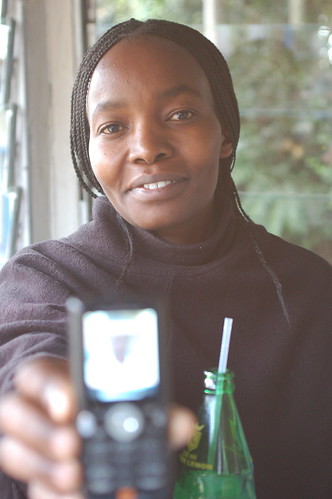
I’ve written about the potential positive effects of mobile technology on global health and human rights before, but I came across a paper from AudienceScapes (PDF) on inequalities in mobile phone access and penetration rates in lower-income countries and thought I’d follow up. The brief, by Gayatri Murthy, outlines the gender and wealth disparities that define mobile phone use and ownership in much of the developing world, despite the huge growth of mobile technology in these locales. As much as I, among many others, have hoped that new information technologies would have a democratizing effect and would increase demand for better health care, human rights, and equality, Murthy’s work, along with a report released by the GSMA Development Fund and the Cherie Blair Foundation for Women in 2010 (PDF), reminds us that there is still a wide gap to traverse.
The GSMA report says that women are 21% less likely than men to have a cell phone in low- or middle-income countries. In her brief, Murthy also points out that in countries with a large wealth disparity, such as South Africa, the privileged are highly connected while those at the bottom of the pyramid remain cut off. Claire Melamed at Global Dashboard goes further, citing the urban/rural, literacy, and financial gaps that are keeping the “bottom of the pyramid” from accessing mobile phones. In GSMA’s paper and Melamed’s post, the conclusion is that someone–governments, the development sector, mobile phone companies–must start working to bridge the divide. As Melamed puts it, “[it’s] the usual public policy problem updated for the mobile age.”
I’ve been relatively optimistic about the potential of mobile and other new technologies for improved health outcomes and other issues, but none of this news comes as a surprise, of course. There are vast inequalities based on social and economic status, gender, and a host of other determinants. The positive aspects of mobile technology, such as its use in various Arab Spring uprisings, crisis management, and mobile banking and health, are encouraging. But more needs to be done. Especially discouraging, as Murthy reports in her brief, is the finding that more Kenyan women rely on personal sources of information rather than on a cell phone for information gathering. Although one survey in Kenya cannot reflect upon mobile phone use in all of the developing world, it has some implications for the efficacy of mobile health (m-health). Before introducing vast m-health and other mobile programs, greater understanding of how, when, and by whom mobile phones are used could help women and other marginalized populations.
The GSMA report outlines a few pilots that are trying to tailor mobile technology programs to decrease the gap and better integrate mobile phone usage in local communities. Tostan‘s and UNICEF’s Jokko Initiative in Senegal trains participants in Tostan’s non-formal education program how to use cell phones and has created a central database to distribute announcements by text (SMS), such as births, deaths, and information about tontines–women’s financial groups. The pilot also hoped to encourage mothers and female community leaders to invest in girls’ health, forgo female genital mutilation (a common problem among some ethnic groups in Senegal) and delay early marriages. Another pilot in Pakistan by Pakistani mobile company Mobilink, UNESCO, and a local NGO that sought to encourage literacy among girls was met with suspicion and some hostility initially by the community due to conservative social norms. As the pilot progressed, however, negative feelings about the program (initially reported as 56% of parents and participants) changed to higher rates of satisfaction with results (87%). The program also had positive results in terms of increasing literacy, with the number of girls receiving the lowest scores dropping 80%, and sent out messages about health and nutrition (which the girls read and wrote down and then wrote responses to instructors about the subjects). These encouraging pilot programs address community norms, development issues like health and literacy, and lack of awareness about mobile phones and how to use them.
What is frustrating is that programs like these take time. Having worked in the global health sector, I can say that efforts like these require studies, research, piloting, tweaking, re-piloting, reporting, publishing, etc., etc., etc. Furthermore, social norms and inequalities are not going to change overnight. Throwing mobile phones at the problems won’t solve them–and could exacerbate them, as those at the bottom are further disenfranchised from the information, connection, and participation that a phone can provide.
At the same time, mobile phone use in the developing world has exploded over the past decade or so–there was a 16% increase in mobile phone subscriptions in the developing world in the last year, as opposed to 1.6% in the developed world (according to Murthy). GSMA postulates that bringing mobile phone penetration among women on a par with men would increase the market by $13 billion in revenues per year and add 300 million users. It also reports that, based on surveys, 93% of women feel safer because of a mobile, 85% feel more independent, and 41% increased their income or professional opportunities. In short, there is a huge economic incentive to close the gender and socio-economic gap and a willingness to use mobile phones, though with the need for programs to educate users and to inform communities of the benefits of mobile technology. In a GSMA survey of women who do not own a mobile phone in developing countries, 42% cited handset (phone) cost as a barrier. So, maybe I’ll retract my previous statement: let’s start throwing phones at the problem and address the other, more intractable issues–illiteracy, poverty, gender inequality–as we go.
With a big hat-tip to Brett Davidson at “Africa is a Country” for this post.